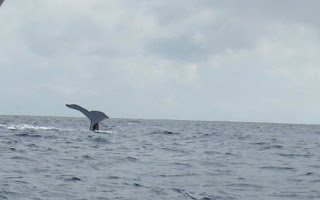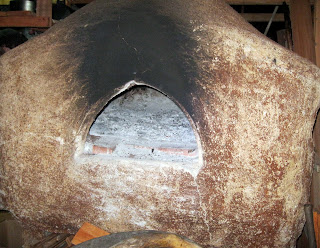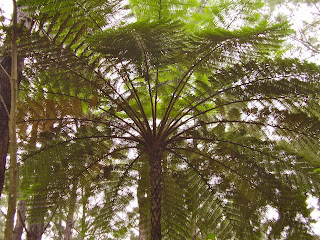Once again on the trail of the whales, we went to 'Eua on August 13. There were six of us, plus two more passengers on our 8-minute flight on Saturday morning. Yes, 8 minutes. It was full of wonder, though, as we viewed Tongatapu from the air, saw whales beneath us in the ocean, and approached 'Eua. We landed on a grass landing strip. A smooth and delightful flight!
We were met by people from The Hideaway where we were staying, and made a quick trip there to leave our luggage. Then it was off to find the whales. Our captain, Kathleen, was determined to find them for us. What a thrill when we finally began to see them far off and sped in their direction. As soon as we got close, two of us (not me or Jim!) got into the water to swim with them. We thought they had left, but Jim got a lucky shot of David swimming with a whale. Success! No videos I had seen, or photos, can ever do them justice when you see them swimming nearby. Truly gentle giants.
 |
| 'Eua's harbor. |
 |
| A wave of the tail. |
That evening we had reserved a dinner with Wolfgang, who works with Deep Blue Diving. He has made a clay/cement outdoor oven housed in a rough outdoor kitchen. We were ready for his special wood-fired pizza. It was plentiful and delicious. (Now I'm ready for our own outdoor oven when we go home. Take note!)
 |
| The oven, and it's red hot! |
 |
| Ready to bake! And we were ready to eat! |
 |
| Wolfgang does the honors. |
On Sunday morning we enjoyed the view of the ocean from The Hideaway, watched whales, walked down to the lookout by the ocean, and just enjoyed being there. By afternoon, though, we were ready for a hike. Perhaps we'd see the 'Eua parrots? After a 15-minute 4-wheel drive transport, we were dropped off with a (sketchy!) map of the area and directions to look for the "blue ribbon." The ground was muddy and full of clay. Walking was a challenge, but we certainly saw some great sights in 'Eua's rainforest, and the fact that it's mountainous was a revelation. Tongatapu, our island, is so flat. We found out later that the elevation is 300+ meters. We heard parrots, and Jim and Jinnet saw one, briefly. The views and the vegetation were outstanding. We did get to the lookout, our destination, but the weather was deteriorating, as we headed back to get picked up. Very tired, but so glad we went.
 |
| A relaxing breakfast. |
 |
| The walk down to the ocean from The Hideaway. |
 |
| This tree caught our attention on the hike. |
 |
| Jim at the lookout. |
 |
| View from the lookout. |
We had to get up at 3:30 the next morning to be off by 4 A.M. to catch the ferry to get a "good" seat. The ferry left at 5. It was packed, by then, with people everywhere. The swells of the waves were hitting the side of the boat, so it was like being on a ride at the fair for a while. It was close to 8 A.M. when we got back to Nuku'alofa and had breakfast at Fresh Cafe. We stopped at the Market to get a few vegetables for the rest of the week and went home to sort out our many unforgettable memories (and dirty laundry).
 |
| View of Tongatapu from the ferry. |
 |
| Coming into Nuku'alofa's harbor. |







